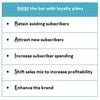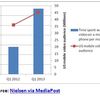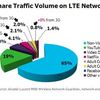In this second installment of the Six Degrees of Mobile Data Plan Innovation blog series, Alcatel-Lucent’s Rich Crowe takes a closer look at service level-based data plans. These plans can be used to give subscribers opportunities to enhance their mobile data services in exchange for a monthly or per-use fee.
What do consumers think about service level-based plans?
In February 2013, Alcatel-Lucent asked mobile broadband consumers in six countries about the concept of service level-based data plans. Globally, two-thirds of respondents said they would be interested in a premium service that could provide an enhanced quality of service (QoS).[1]
Service level-based data plans allow mobile network operators to expand their data plan offerings beyond today’s unlimited and tiered plans. With service level-based plans, operators can offer subscribers premium services that deliver a higher speed or QoS than that provided to typical users. Subscribers pay for these services with monthly or per-use fees.
The Alcatel-Lucent survey gauged interest in the service level-based plan concept by proposing three premium services to consumers:
- Premium subscription: For an additional monthly charge, the operator delivers all of the subscriber’s mobile data services at double the speed provided to the typical subscriber. The speed increase is valid for the entire month.
- Turbo boost: For a fee, the subscriber receives a speed boost for one hour. Subscribers can buy as many turbo boosts as they want in a month, but they pay a separate fee each time.
- Application boost: For an additional monthly charge, the operator delivers mobile data for a specific set of applications at double the speed provided to the typical user. For example, a subscriber could choose to boost social media, web browsing and GPS applications. The speed increase for the selected applications is valid for the entire month. All other applications continue to receive the normal data rate.
Respondents who were interested in premium services showed an overwhelming preference for the premium subscription option. These consumers are looking for a boost that applies to every service, application and location. The premium subscription was the most popular choice in all surveyed countries, as shown in Figure 1.
Figure 1: Gauging interest in premium services that enhance QoS
The degree of interest in service-level based plans is telling. It’s even more telling when we consider that over 83% of survey respondents said they are satisfied or very satisfied with their current mobile service. We might expect subscribers to require a baseline QoS as part of their existing data plan. Or, we might expect that moving to LTE would be sufficient to boost QoS. However, subscribers seem to accept that there will be variations in QoS based on location and time of day. They’re interested in service level-based plans that give them the flexibility to enhance and personalize their mobile data services.
Will subscribers pay for premium services?
The real test, of course, is whether subscribers are willing to pay for premium services. Together with Bell Labs, Alcatel-Lucent analyzed survey respondents’ feedback on premium service pricing. The analysis focused on input from those who said they would be likely or very likely to buy if they felt the price was right.
Survey analysis showed that the optimal price for a premium subscription is about $10.00 per month (all prices in US dollars). For an application boost, it’s approximately $6.50 per month, about the same as the optimal per-use price for the turbo boost service. The comparatively high turbo boost price may indicate that those interested in this service don’t think they’ll use it frequently but are willing to pay for it in specific instances.
Deeper analysis revealed that how often subscribers use an application may not be the best indicator of their willingness to pay to boost its performance. This reinforces the idea that different data has different value, and that operators can segment and price the data market in a way that captures more revenue for higher-value data. For example, the most popular applications across all respondents were social networking, news, games, entertainment and utilities. However, respondents were most likely to pay to boost the performance of productivity, health and fitness, and entertainment applications.
Delivering service level-based plan innovation
Operators need a few key network capabilities to deliver service level-based data plan innovation. As always, online charging and subscriber data management systems are must-haves. Policy control is essential for determining what QoS is to be applied for different subscribers and applications, and for telling the packet core how to enforce these QoS distinctions.
Network analytics, offer orchestration and an intuitive self-care interface can be added to further enrich the subscriber experience. For example, when a subscriber purchases a streaming video, real-time analytics can be used to determine the level of network congestion. If the network is not fully congested, a turbo boost can be offered to the subscriber. By accepting the offer, the subscriber enjoys a better QoS and creates revenue for the operator. In other words, everyone wins.
Read the ‘Six Degrees of Mobile Data Plan Innovation’ blog series:
Bringing customers closer: Six degrees of mobile data plan innovation
Up next in our series: shared data plans
[1] Alcatel-Lucent Consumer Mobile Broadband Survey, February 2013.











